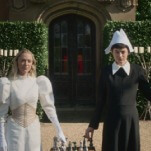Doctor Who: "The Beast Below"

If one of the keys to keeping Doctor Who successful is finding new ways to scare successive generations of children, “The Beast Below,” the second episode of the Steven Moffat era, has to be considered a raging success based on its opening scene alone. As schoolchildren file past an automaton teacher cast in the likeness of a creepy old carnival attraction, they’re praised and sent on their way. Unless they’re not, like our poor Timmy. Given a zero, Timmy watches as the wooden schoolteacher’s head changes from kind—if still creepy—to stern. Soon he’ll see it has a third face, assuming he got a chance to see it before falling into open space to his apparent death.
Scared yet? Like the stone creatures of “Blink,” these wooden authority figures appear at once familiar and threatening. They’re uncanny in the original sense of the word, and Moffat finds ways to make the uncanny serve as a pipeline to terror. So is it worth quibbling that they don’t really make that much sense as authority figures in the democratically chosen dystopia of “The Beast Below”? Why would Starship UK choose these particular beasties, 20th century remnants from a Blackpool tourist trap, to keep order? The only answer I can think of is that its secretly run by Steven Moffat.
In fact—spoilers ahead, of course—the whole system kind of falls apart under scrutiny. If the Starwhale refused to eat children all those years, where did all those children go? Were their memories erased before being sent back above? But didn’t everyone think them dead already? If the age-retarding technology used to keep Liz 10 (spirited guest star Sophie Okonedo of Hotel Rwanda fame) was public knowledge, wouldn’t the public demand access to it? Did everyone just agree to keep it secret, and keep it exclusively for the Queen, out of respect? Did they just forget when they hit the “forget” button?
I could go on, but I won’t because I enjoyed “The Beast Below” too much to nitpick it (too much) and I think the “forget” button can be used to explain away almost any perceived flaw in the system. It’s pretty convenient that way. So what of the rest of the episode? As has become tradition, the Doctor’s first adventure with a new companion throws said companion in the deep end. Amy begins the episode floating in nightgown-clad delight outside the TARDIS—any resemblance to Peter Pan’s Wendy is purely coincidental, I’d wager—but scarcely has time to say “fish fingers and custard” before she’s forced to think for herself in a none-too-welcoming vision of a future United Kingdom. (One that comes complete with a Northern Ireland but, pointedly, no Scotland.) Let’s pause a moment before joining her. That voiceover narration and the frequent references to her impending nuptials—and her reluctance to reveal her engagement to the Doctor—suggest Amy’s overarching story will play a bigger role than even Rose’s story in the season (seasons?) to come. Well, that and the too-thick-to-ignore chemistry between Amy and the Eleventh Doctor.








































